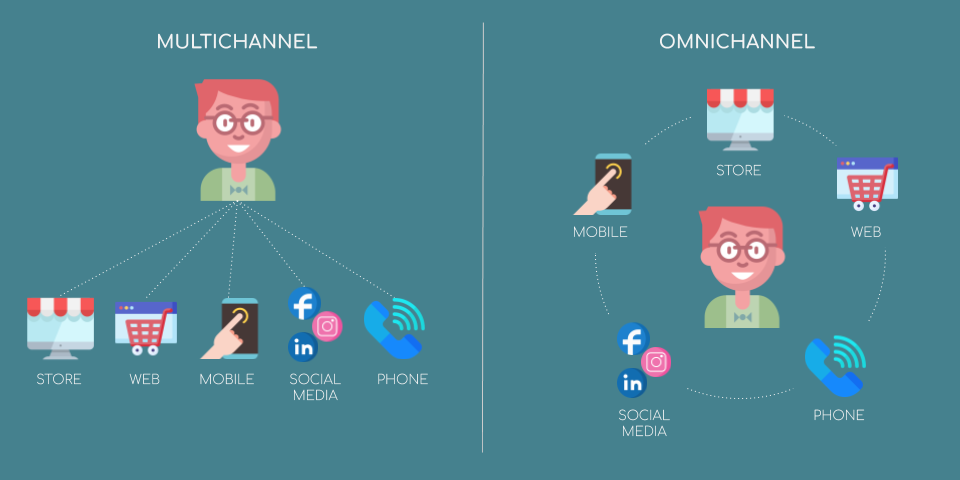Omnichannel user experience and UX strategies can be the deciding factor between you and your competitor. You may have a more affordable offering but if your customer values convenience over price, you won't be their first choice.Optimizing the end-to-end user experience provides an invaluable offering to your customers, it allows them to complete their task with ease across devices and interaction channels.
What is Omnichannel Experience?
An omnichannel is a cross-channel strategy with the aim of creating better relationships with users across all points of contact. The idea is to provide 360-degree involvement and engagement of the customers with a brand across all the available touchpoints.
Omnichannel vs Multichannel experience
As opposed to multichannel, where all channels like websites, blogs, FaceBook, Twitter, etc may be available to customers but aren't integrated, omnichannel and their supporting resources are all integrated to cooperate together.Omnichannel is therefore taking the multichannel experience one step ahead by providing different channel options where users can move seamlessly between them. Most companies investing in the omnichannel approach align their goals across each channel as well as devices to enhance their marketing efforts.

Digital solutions are not only important in this day and age but necessary, we have all seen a rise in technological solutions due to the Covid-19 pandemic all over the world. It has become a necessity for businesses to have a digital presence in order to survive, and not only that, but to establish a seamless omnichannel experience to thrive.Take for example, retail stores were closed during certain intervals of the lockdown. Customers were not able to walk into the brick-and-mortar stores to do their shopping and so businesses had to shift the focus on digital presence to encourage their customers to buy online.[video width="332" height="720" mp4="https://cdn.netizenexperience.com/wp-content/uploads/2021/02/Omnichannel.mp4"][/video]Uniqlo established an online shop on their social media channel. As we can see in the video, customers are able to view their product offerings on Instagram and click through to view the product in more detail.However, when the customer decides to click on 'view on website' to proceed and buy, the website shown is the main page, not the selected product page. This causes a breakdown in what is meant to be a seamless experience and instead leaves the customer feeling annoyed in having to look for the product all over again on the website, and abandoning the sale entirely.The purpose of an omnichannel retail strategy is meant to provide customers with a fully-integrated shopping experience, uniting all the user experiences from various channels: brick-and-mortar to mobile-browsing, social media and everything in between.If Uniqlo was able to show the customer the selected product page, it would have been a seamless connection between their social media channel and their website channel.
The Importance of Omnichannel User Experience
User experience needs to be more dynamic and connected than ever, separate interactions like multichannel experience is a thing of the past. Your business needs to be like a well-oiled machine in providing your customers with a seamless experience in simplifying their user journey.Looking at the user experience on a micro-level is to evaluate the individual interactions, whereas the macro level is to look at the omnichannel user experience. The customer journey isn't restricted to a singular channel anymore but instead spans across all the available channels.There are several reasons to support the omnichannel user experience. Customers now own several devices and each of their devices comes with different possible interactions with the same business. For example, your customer could choose to use their phone to browse your website, make a transaction through a mobile app, get updates and browse on social media, as well as checking the email for newsletters and make calls to your business.There are so many channels across various devices, and this makes the customer-business relationship more complex than before. With more channels available, along comes more opportunities for failure.The changing landscape of technologies and devices have provided new and ever-changing means for customers to interact with businesses. These new opportunities need to be met with new and improved customer experiences in which omnichannel experience is vital for achieving a successful and holistic user experience.Furthermore, with the new interaction opportunities, customers' expectations have evolved and they now expect so much more. Your users have the devices and technologies that can support a customized and pleasant customer experience and they fully expect businesses to deliver.Gone are the days of confinement to singular channels and ways of interacting, customers want to be empowered in the user journey and be able to transition seamlessly from one device to another in whichever way is convenient for them. Omnichannel experience is essential for businesses in catering to these customer demands.While it can sometimes be challenging as well as expensive to create APIs and backend platforms for omnichannel experience, it is definitely worth the investment.
How to Create an Effective Omnichannel Experience
An effective and properly designed omnichannel ecosystem results in an exceptional user experience. In order to create an effective omnichannel user experience, your business needs to understand and conduct a user journey research that your customers go through in order to complete their tasks across various devices and channels.The journey for each customer is a holistic interaction with your business, it's a singular experience rather than a collection of individual experiences. This means that their interaction with your social media and your website aren't two separate experiences but an aggregated experience with your business as a whole.Because of this, customers don't understand fragmented experiences across channels and get frustrated when there are obstacles. Businesses need to stop thinking about individual solutions per channel and enhance the journey and experience across all the channels.In order to design the most appropriate experience for each channel and to design a seamless transition and experience across all the channels, there are 7 components that need to come together in order to create a successful omnichannel user experience:
- Consistent: To provide a consistent, comprehensive, familiar experience across all channels
- Optimized: Individual channel experiences that are optimized for each particular device, adhering to each channels' constraints and contexts of use
- Seamless: To create effortless channel transitions, helping customers pick up right where they left off when they choose to switch from one channel to another
- Orchestrated: Guiding customers through their journey with the right interactions and timely messages that are personalized
- Collaborative: Empowering customers to take advantage of multiple channels at the same time, enriching the customer journey in improving the overall user experience
- Availability across all touchpoints: Consumers in the present day want the freedom to decide when and where they want to interact with your brand. It is therefore important to offer them a range of channels and transition them to the appropriate channels seamlessly.
- Channel neutrality- Omni channel UX design does not really believe in driving the customers to a single channel, even when tempting to do so. Here, all touchpoints work together to provide the best experience for the users. While within a corporate structure, it could mean that competing teams will now be required to work together, it has various positive implications for customer experience.
Having these 7 components make all the difference between having an effective and cohesive omnichannel user experience and simply having solutions on various channels.
Examples of brands using omni-channel user experience
- Disney- the company uses omnichannel marketing strategy right to the smallest details. Whether you’re surfing their mobile responsive website to plan a trip, using My Disney Experience tool to secure your Fast Pass, or using their mobile app within the park, the transitions are well integrated and smooth.
- Bank of America- This organisation definitely takes their UX seriously. The company’s mobile and desktop apps provide a dynamic experience for users to manage their activities and workings with the bank.
- Starbucks- The company’s rewards app provides a wonderful omnichannel experience. Once you get your card (after making a purchase), you can reload it with your phone, their website, within the app or in-store.
Various other leading brands line REI, Oasis, Virgin Atlantic, Chipotle have deployed smart omni-channel UX strategies to provide seamless interactions across all channels being used by their customers.Want to get started on creating an effective omnichannel user experience? Check out our related article: 'How to Create a Consistent Omnichannel User Experience' to take the first step.





